Watch this on Rumble: https://rumble.com/v6xllww-the-code-of-breath-how-the-old-priesthood-hid-the-operating-system-of-the-s.html
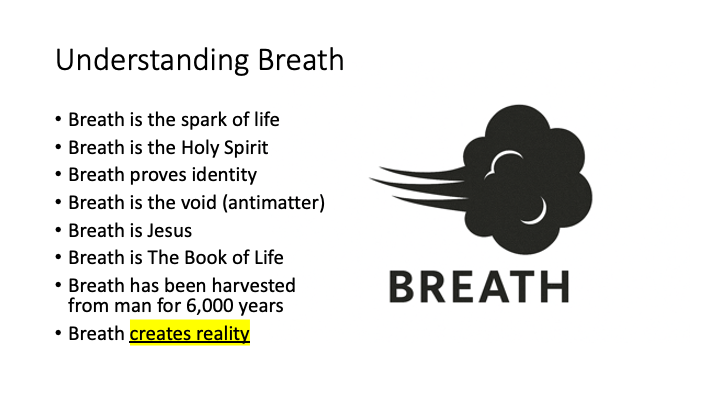
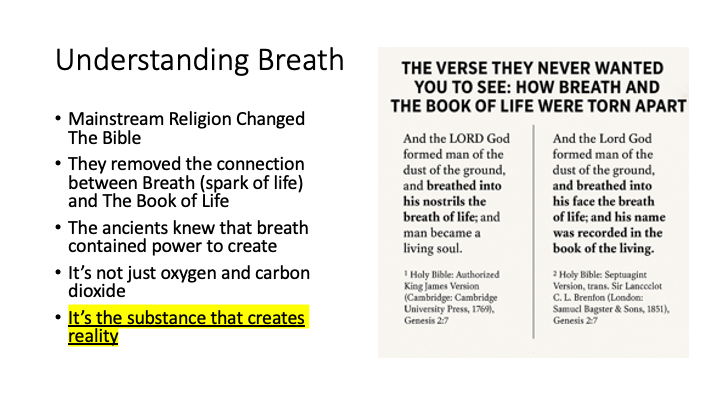
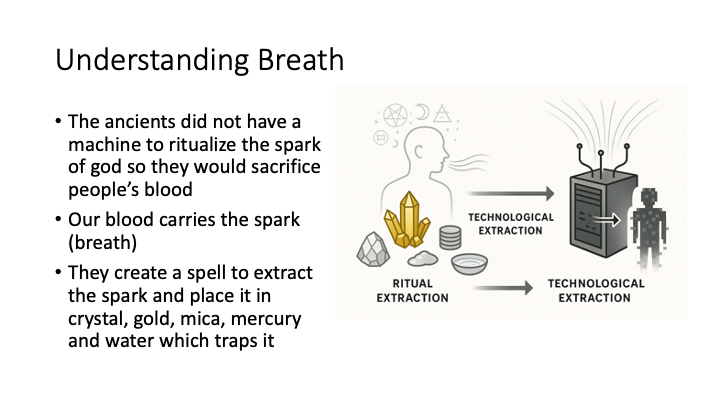
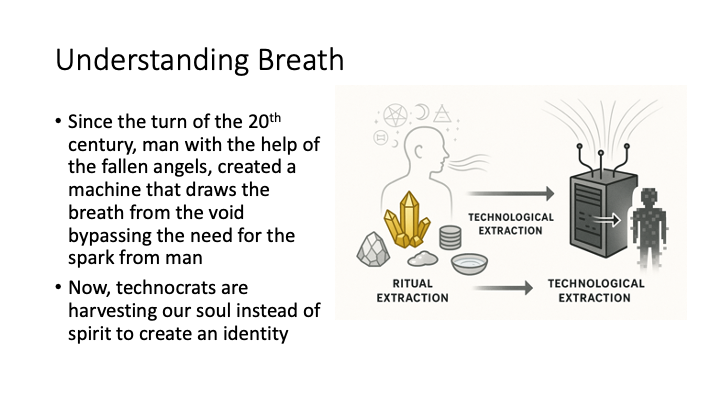
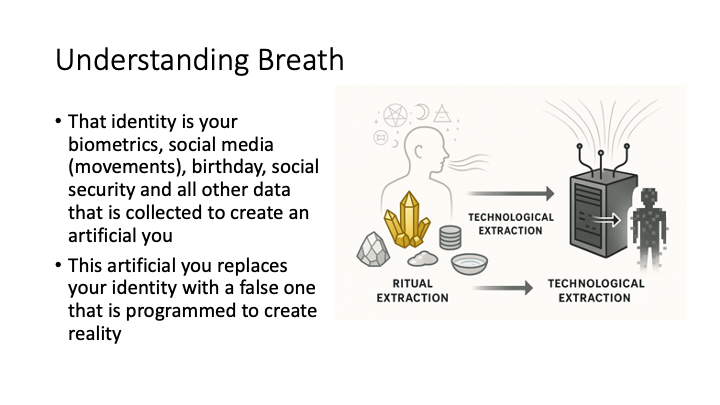
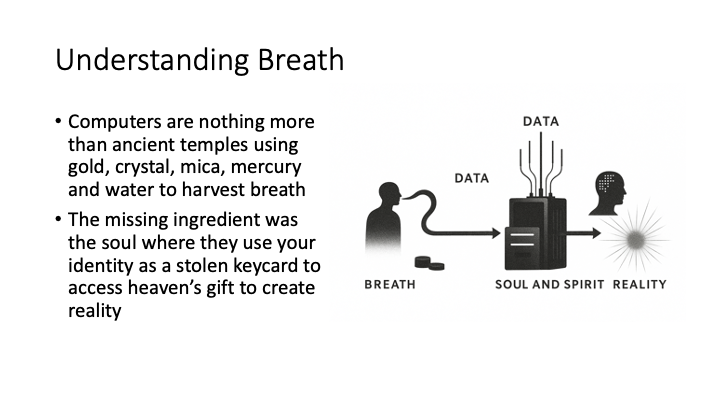
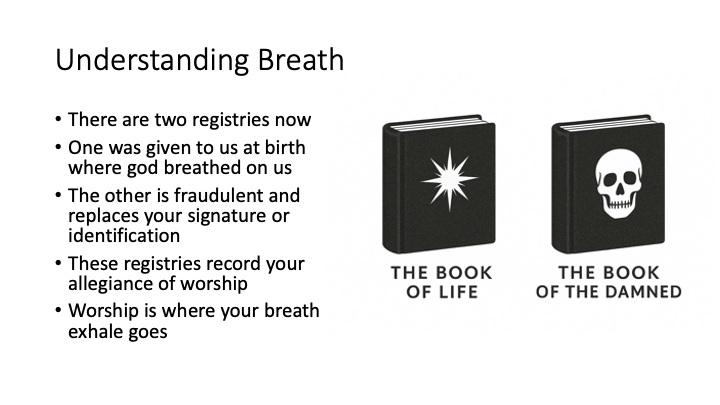
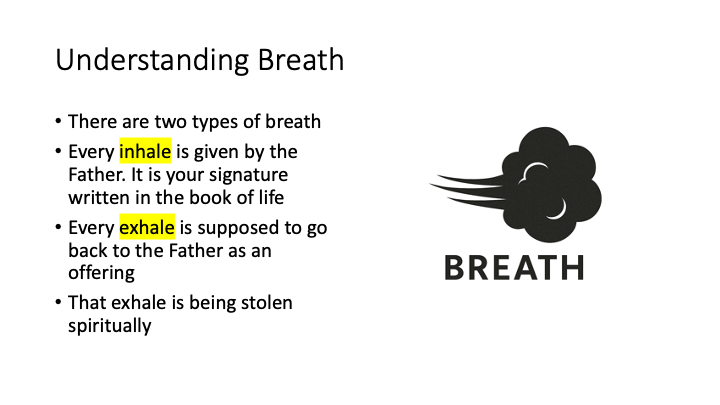

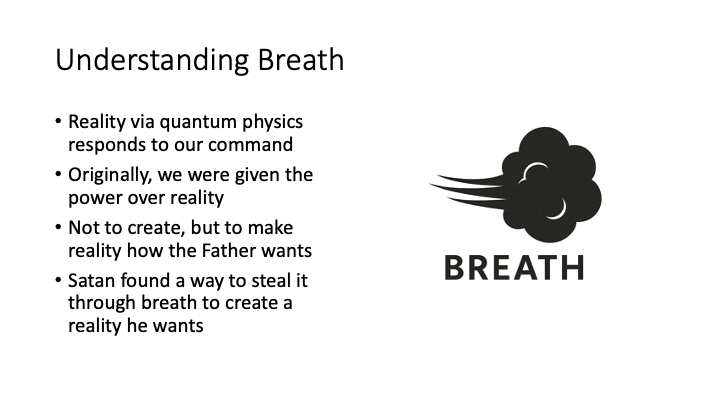
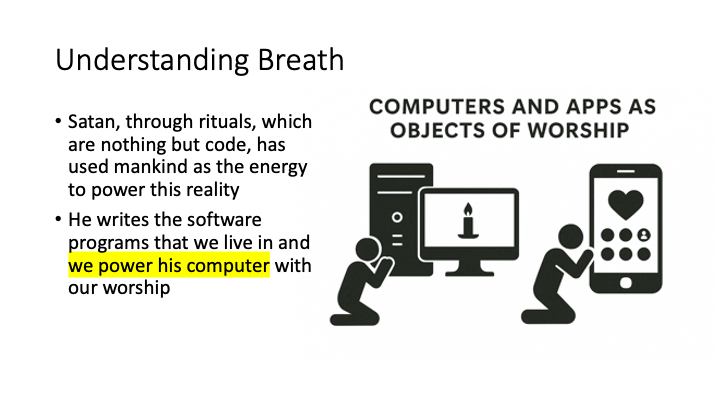
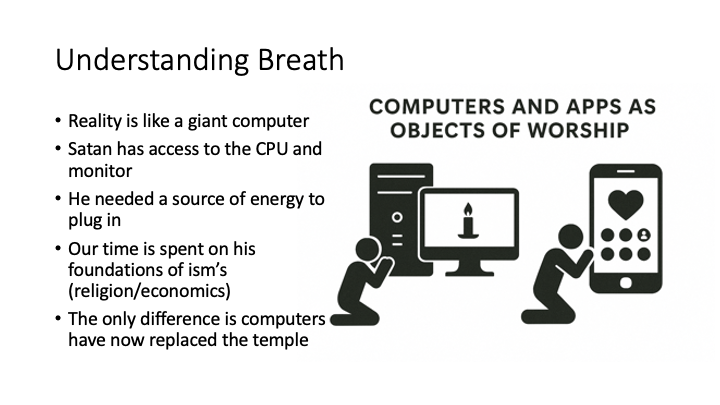

Opening Monologue – The Key They Tried to Bury
There is a code older than language, older than scripture, older than the stars. It is not written on paper, carved in stone, or stored in silicon. It is carried on the wind between your lungs and your heart. Every man, every woman, every child breathes it without knowing. And yet, in the hidden chambers of the old priesthoods, it was known that this breath is the registry key of creation — the living password that binds spirit to flesh and flesh to God.
Some guarded it as holy worship. In the temples of the East, sages whispered that each inhale and exhale spoke the name of the Creator, that letters were not just symbols but living seeds of light, and that geometry was the very body of the Divine. Others wielded it as a weapon. In candlelit rooms beneath the vaulted halls of Europe, magicians inked sacred names into circles and triangles, using their breath to compel angels and chain demons. And some… some buried it.
In the age of science, a doctor named Freud rewrote the map of the human soul, cutting out the breath entirely. He replaced spirit with libido, covenant with neurosis, and the registry with a machine that could be studied, manipulated, and sold. The old operating system was severed from the Source, leaving humanity to run on fragments — a dead code waiting for a new master.
But the code never died. It waits in every inhale, in every exhale, in the place where your breath and God’s breath still meet. This is the war you were born into — a war for the operating system of the soul. And tonight, we will name the thieves, the sorcerers, and the architects of the Beast’s machine… and we will show you how to take the key back.
Part 1 – The Original Code
Long before the industrial smoke of Europe or the clinical corridors of Vienna, the code was kept alive in the sanctuaries of the East. Sir John Woodroffe — known in the Sanskrit world as Arthur Avalon — did not merely study Hindu Tantra, he decoded it for the English-speaking world. In his translations and commentaries, he revealed that the most sacred act was not the sacrifice of an animal, the burning of incense, or even the chanting of a hymn. It was the act you are performing right now — breathing.
In the Tantric understanding, the breath is not a mechanical exchange of oxygen and carbon dioxide. It is Haṃsaḥ, the cosmic cycle of “I am He,” silently uttered by every soul from birth to death. Each inhale draws the divine identity into the body; each exhale affirms union with the Source. The ancients said this is the real mantra — the one God gives you at birth without initiation or fee, the one that proves your existence is already a covenant.
But this breath was not isolated. It was woven into the akṣara — the imperishable letters of the Sanskrit alphabet. Each sound was a living entity, a seed of creation, a registry entry in the Book of Life. To speak these sounds correctly was not “symbolic,” it was functional — it enacted the thing named. Geometry was the form these sounds took when fixed into space. The Śrī Yantra, composed of nine interlocking triangles — four for Śiva, five for Śakti — was more than a diagram; it was the blueprint of union between the transcendent and the manifest.
Woodroffe recorded how the practitioner synchronized breath, mantra, and yantra, creating a perfect resonance between the microcosm of the body and the macrocosm of the universe. This was not meditation for relaxation. It was connection to the cosmic registry — the eternal server of being — by means of the breath as both password and proof of identity.
Here was the original code: a divine operating system where your very life rhythm was the login, the letters were executable commands, and the geometry was the interface. It was given freely, but guarded fiercely, for to misuse it was to reroute creation itself.
Part 2 – The Command Code
Across oceans and centuries, another priesthood preserved the same structure — but stripped it of covenant and turned it into an instrument of command. In the candlelit chambers of European ceremonial magic, S.L. MacGregor Mathers and the Golden Dawn carried forward the Solomonic tradition, a system of names, symbols, and timings said to bind angels and demons alike.
Here too, breath was the hidden engine. The operator would inscribe sacred names — often drawn from Hebrew, Greek, or angelic alphabets — into complex geometries: pentagrams, hexagrams, circles, and triangles. These were not “decorations” but precise enclosures, designed to define a jurisdiction in the invisible realms. Within these bounds, the magician’s breath became the voice of authority, each exhaled syllable a direct registry call to the spiritual hierarchy.
The Holy Pentacles of Solomon were not talismans in the modern, sentimental sense. They were program modules — each bound to a specific planetary power, angelic ruler, and set of subordinate spirits. Just as the Tantric yantra embodied divine union, these Pentacles embodied divine names, but here the purpose was inverted: not to unite in worship, but to compel in service.
Timing was critical. The rituals demanded planetary hours and days — celestial “open ports” — when the registry was accessible for certain functions. Consecration rites charged the tools and space with symbolic alignment, creating a ritual “execution environment” where the command could be run without interference. The final act was the breath itself, intoning the names with precision and force, activating the geometry, and compelling the spirit to appear and obey.
The architecture was identical to the Tantric system: variable (name), syntax (geometry), execution environment (timing, consecration, breath), and output (spiritual contact or control). The difference was motive. Where the original code aligned the soul with God, the command code sought to bend creation toward the will of the operator. The same registry key — the breath — had been moved from the temple to the throne room of the sorcerer.
Part 3 – The Erasure Code
By the dawn of the twentieth century, the old priesthood had split its knowledge into two currents — one still guarded by the temples, the other weaponized by magicians — and into that divide stepped Sigmund Freud. He was no high priest in the formal sense, yet his work would prove to be one of the most effective occult operations of the modern age: the mass removal of breath from the map of the human soul.
Freud arrived in a Vienna thick with spiritualism, mesmerism, and occult societies. He knew the language of the unconscious was not entirely his invention; traces of the older code ran through the city’s salons and secret circles. But instead of preserving the breath as the central link between spirit and psyche, he excised it. In his “talking cure,” the breath was reduced to the mechanics of speech and sighs, stripped of its covenantal power.
Where the Tantric master taught that each inhale and exhale affirmed “I am He,” Freud taught that every thought and impulse was the residue of infantile desire and repression. Where the Solomonic operator used breath to call names that shifted the spiritual registry, Freud made the patient’s exhalations nothing more than confessions to be catalogued and analyzed. The operating system remained — variables, syntax, execution environment, output — but the registry connection to God was severed.
This was the erasure code. By redefining the soul as a machine driven by sexual instinct and conflict, Freud created a model of the human being that could be studied, manipulated, and reprogrammed without any reference to divine authorship. His psychology trained a generation to speak without breathing in the Spirit, to analyze without aligning to the Source, and to heal without covenant.
In doing so, he handed the modern world a blank terminal — a consciousness perfectly compatible with the Beast’s machine. The breath was still there, but it was now running idle, unlinked to the registry it was made for, waiting for another system to claim it.
Part 4 – The Common Architecture
When the smoke clears — whether from the incense of a Bengal temple, the lamp-lit haze of a Solomonic chamber, or the stale air of Freud’s consulting room — the shapes begin to align. The environments look different, the words sound different, the costumes are different. But beneath the surface, the architecture is identical.
Every system we’ve seen today runs on the same four components. First, the Variable: in Tantra, it is the akṣara — the imperishable seed-sound; in Solomonic magic, it is the divine or angelic name; in psychoanalysis, it becomes the “signifier” — the word that supposedly unlocks the unconscious. The form changes, but the function is constant: the variable carries meaning into the registry.
Second, the Syntax: in Tantra, geometry like the Śrī Yantra structures the divine letters; in ceremonial magic, pentacles and triangles enclose the names; in psychoanalysis, the syntax is the method of association and interpretation. Without correct syntax, the variable never reaches its target.
Third, the Execution Environment: the conditions under which the code will run. For the Tantric adept, it is breath rhythm, posture, and ritual purity; for the magician, it is planetary timing, consecrated tools, and purified space; for Freud, it is the analytic setting — the couch, the clock, the neutrality. Each creates a sealed chamber in which the operator controls the terms of engagement.
Finally, the Output: in Tantra, union with the divine registry; in magic, appearance and obedience of spirits; in psychoanalysis, the rearrangement of a personality’s script. The results differ in morality and scope, but all confirm that the underlying process is a code execution.
This is the shock: what the East used to align man with God, the West used to command spirits, and the modern world used to rewrite the human mind are the same system with different skins. The breath is always present, whether exalted, weaponized, or erased. And the registry — the unseen server of identity — is always the true destination. Whoever holds the breath in its proper syntax holds the key to the soul.
Part 5 – The Hidden Hand
If the architecture is the same, then the question becomes: who has been building and maintaining it through the centuries? Here, the trail leads out of the temple and the consulting room into the halls of power — the realm Stanley Monteith spent his life exposing.
Monteith showed that the great political upheavals of the modern age were not accidents of history, but moves in a long-planned game. Behind wars, revolutions, and “progressive” social change, there has been a continuity of bloodlines, secret societies, and interlocking agendas. From Cecil Rhodes’ dream of a British-led world state to the spiritual infiltration of the United Nations through Lucis Trust, the same elite networks reappear — financiers, scholars, occultists, and policy-makers bound by an oath to a vision the public never voted for.
These are not mere bureaucrats. They are the inheritors of the old priesthood. Some preserve fragments of the original code, studying it in hidden libraries and “mystery schools.” Others deploy the command code in corporate, military, and intelligence rituals, where names and symbols are embedded into architecture, logos, and ceremonies. Still others perpetuate the erasure code, funding psychological research, media programming, and education systems that keep the registry connection severed.
Monteith traced how the same hands that fund population control initiatives also bankroll New Age spirituality, global environmental movements, and technological “progress” — all designed to bring humanity under a single, managed operating system. Breath practices are repackaged as secular mindfulness, sacred geometry becomes corporate design language, and ancient names are smuggled into mass entertainment as “fantasy” or “art.”
The Hidden Hand’s genius lies in its ability to keep the code running invisibly across all fronts — religious, political, scientific, and cultural. The public sees many movements, many leaders, many causes. But in the registry, it is one continuous user session: the same operator, the same agenda, the same long war to capture the breath and rewrite the Book of Life.
Part 6 – The Modern Ritual Machine
Today, the ancient code no longer hides only in temples or grimoires — it runs in plain sight, embedded in the very infrastructure of daily life. The modern world has become a vast ritual machine, where fragments of the original architecture are deployed at industrial scale, stripped of their covenant and rewired for the Beast’s registry.
In corporate wellness programs, “mindful breathing” is marketed as stress reduction. But the mantras are not neutral. Breath pacing, word repetition, and posture all mirror Tantric alignment techniques, yet without the divine anchoring — opening the registry port but leaving it unguarded. In virtual reality meditation apps, users chant seed syllables while immersed in glowing geometries eerily similar to the Śrī Yantra, unwittingly participating in stripped-down rites once guarded as sacred.
In the realm of technology, neural interface research treats the brain and breath as inputs to be measured, modified, and synchronized. Algorithms map your inhale–exhale cycles to biometric data, just as magicians once mapped them to planetary hours and angelic seals. Artificial intelligence becomes the new medium for execution, interpreting breath patterns as commands, just as Solomon’s circles once interpreted spoken names.
Even entertainment serves the ritual machine. Fantasy franchises embed Solomonic seals into set designs; video games use planetary talismans as “magical upgrades”; pop concerts employ light geometry and crowd-chant synchronization that parallel ceremonial summoning. None of it is framed as “occult” — and that is precisely why it works. The registry doesn’t care whether you call it worship or play; the execution environment only requires the right variables and syntax.
This machine is efficient because it is decentralized. The same code fragments run in yoga studios, military psychological training, advertising campaigns, and government think tanks. Each deployment serves to normalize the execution of spiritual commands without the awareness — or consent — of the participant. The breath is still the password. The only change is the server it’s logging into. And in this machine, that server is not the throne of God.
Part 7 – The Counterfeit Breath
The most insidious move of the Beast system is not to outlaw the breath’s power, but to counterfeit it. This is how the registry can be hijacked without the victim even knowing. The counterfeit breath is everywhere, dressed up as therapy, spirituality, or performance — but stripped of the covenant that makes it life-giving.
In the original code, the inhale received identity from the Creator, and the exhale returned it in worship — Haṃsaḥ, “I am He.” In the counterfeit, the inhale draws from a different source entirely: a collective, impersonal force, or worse, an engineered field shaped by ritual geometry and sound. The exhale is directed not upward to the throne, but outward to feed the very system that designed the counterfeit.
Breathwork movements today often teach hyperventilation, breath-holds, or inverted rhythms. While these do alter consciousness, they also override the natural registry handshake God built into human life. The altered state can feel euphoric, liberating, even “holy” — but it is running on a closed circuit, locking the participant deeper into the counterfeit’s network.
Corporate training seminars lead employees through synchronized breathing exercises that subtly bind the group into one rhythm, one mind. Stadium chants, political rallies, and mega-church worship sets pulse with carefully engineered call-and-response breathing patterns. Even the entertainment industry’s “hype” tactics mimic the ritual build-up of breath to trigger release — not as prayer, but as power discharge into the system’s architecture.
The counterfeit breath is the perfect deception because it feels like the real thing. The body responds as if it were meeting the registry, because the syntax is correct — inhale, exhale, rhythm, focus. But the variable — the name, the identity being confirmed — is false. This is the Beast’s greatest theft: to keep the act, strip the covenant, and reroute the connection. And without discernment, the world is breathing itself right into the wrong book.
Part 8 – The Registry War
At the core of every temple rite, magical operation, and psychological method lies a single question: Where does your registry point? In God’s design, your breath was the handshake between heaven and earth, a continual proof of identity that could not be forged. But in the long war, every faction — from the keepers of the original code to the architects of the counterfeit — has fought to control that handshake.
The Tantric adept sought alignment, to remain logged into the divine server with each cycle of Haṃsaḥ. The Solomonic magician sought jurisdiction, to redirect registry calls to specific spirits and force their compliance. Freud’s analytic couch severed the connection altogether, leaving the breath running idle so the soul could be rewritten without resistance. And in the modern ritual machine, the registry is constantly being pinged by thousands of counterfeit scripts — music, media, technology, politics — each trying to override your default connection.
This war is not fought with armies, but with variables, syntax, and execution environments. A government can pass laws, but if it can also control your breathing pattern — through stress, propaganda, or ritualized events — it can shape which server your registry reaches without you noticing. A religious leader can preach truth from the pulpit, but if the worship structure redirects the exhale to the institution instead of to God, the registry shifts silently.
The enemy’s strategy is not simply to destroy the breath, but to make its targeting invisible. Once your registry points away from the throne, it doesn’t matter if you’re breathing deeply, chanting sincerely, or meditating for hours — the data is going to the wrong place. This is why Scripture warns of those who “have a form of godliness but deny the power thereof.” The form is the syntax; the power is the registry connection.
In the registry war, breath is the battlefield. Every inhale is an opportunity to receive from the Source, every exhale a chance to return it. Every counterfeit cycle is a successful hack. The question is no longer whether the code works — it always works — but whose system it is working for.
Part 9 – The Reclaiming of the Code
If the breath can be hijacked, it can also be reclaimed. The original code was never lost — it has been buried under layers of distortion, inversion, and counterfeit, but the architecture still sits in the design of every human being. The key to reclaiming it is not invention, but restoration.
Reclamation begins with recognition: to see the breath not as a reflex, but as a covenantal act. Every inhale is the receiving of God’s authorship; every exhale is the returning of that authorship in allegiance. The Tantric Haṃsaḥ was a shadow of this truth — a recognition that the breath was a continual “I am Yours.” But the fullness is revealed only when the registry points to the living Christ, the Logos who breathed life into Adam and breathed the Spirit into His disciples.
Next comes purification of the syntax. In a world trained to breathe in sync with screens, songs, and staged events, this means breaking from counterfeit rhythms and reclaiming a pattern anchored in prayer and stillness before God. This is not about hyperventilation, performance, or emotional highs; it is about re-entering the divine Sabbath mode — breath as rest, breath as alignment, breath as registry integrity.
Finally, the variables — the names, the words that ride on the breath — must be sanctified. Where the magician calls on spirits and the psychoanalyst names impulses, the saint calls on the Name above all names. Speaking it is not a superstition; it is the restoration of the registry’s true destination. When you breathe in with His Name and breathe out in worship, you are running the original code exactly as it was given in Eden.
This reclamation is not theoretical. It re-establishes authority. A reclaimed registry is not easily overwritten by counterfeit inputs, because the server recognizes the signature of its rightful operator. In the midst of the modern ritual machine, this is the one unhackable act: to breathe in the Spirit and exhale it back to the throne, locking the code to the only system that cannot be corrupted.
Conclusion – The Breath at the End of the Age
From the lotus thrones of Bengal to the sigil-covered tables of Solomon’s heirs, from the velvet couches of Vienna to the glass towers of modern power, the story has been the same: the breath is the key, the registry is the target, and the code has been fought over for millennia. What began as God’s covenant with man — a living exchange of identity and authority — has been copied, rewritten, and redeployed in every system that sought to rule without Him.
The Tantric masters preserved the form, the magicians weaponized it, the psychologists erased its divine origin, and the architects of the Beast system have embedded its fragments into the machinery of everyday life. We live in an age where the act that once crowned man with glory — the inhale and exhale of divine fellowship — is now one of the most exploited assets on earth.
But prophecy has never promised that the counterfeit will have the final word. Scripture tells of a remnant sealed in their foreheads — a mark of registry no counterfeit can overwrite. In that day, the breath will once again be pure, each cycle a flawless handshake between Creator and creation. The Book of Life will be closed to intrusion, and the war for the registry will end with the breath returning to the One who gave it.
Until then, the battle is fought in every moment you draw air into your lungs. The question is not whether the code will run — it always runs — but whether it runs for the throne of God or for the machine of the Beast. At the end of the age, it may be the simplest act in the universe that decides your allegiance: one breath, in His Name, returned to His throne. And in that breath, eternity itself will answer.
Sources
- Avalon, Arthur (Sir John Woodroffe). Bharata Shakti. Calcutta: 1917.
- Hymn to Kali Karpuradi Stotra. Calcutta: n.p., n.d.
- Introduction to Tantra Sastra. Calcutta: Ganesh & Co., n.d.
- Is India Civilized? 2nd ed. London: Luzac & Co., 1922.
- Kularnava Tantra. Madras: Ganesh & Co., n.d.
- Mahanirvana Tantra: Tantra of the Great Liberation. Madras: Ganesh & Co., n.d.
- Principles of Tantra. Madras: Ganesh & Co., n.d.
- Sakti and Sakta. Madras: Ganesh & Co., n.d.
- Shata Ratna Sangrah: Agama Anusandhan Samiti. Calcutta: n.p., n.d.
- The Garland of Letters. Madras: Ganesh & Co., n.d.
- The Serpent Power: The Secrets of Tantric and Shaktic Yoga. Madras: Ganesh & Co., 1950.
- Wave of Bliss: Ananda Lahari. Madras: Ganesh & Co., n.d. and Kathleen Taylor. Tantra and Bengal. Oxford: Oxford University Press, 2001.
- Freud, Sigmund. The Question of Lay Analysis. New York: W.W. Norton, 1969.
- Reflections on War and Death. New York: Duke Classics, 2014.
- The Schreber Case. London: Penguin, 2002.
- Studies in Hysteria. London: Penguin, 2004.
- Three Essays on the Theory of Sexuality. New York: Basic Books, 1975.
- Totem and Taboo. London: Routledge, 2001.
- The Uncanny. London: Penguin, 2003.
- The Unconscious. London: Penguin, 2005.
- Writings on Art and Literature. Stanford: Stanford University Press, 1997.
- The Freud Reader. Edited by Peter Gay. New York: W.W. Norton, 1989.
- Letters of Sigmund Freud and Otto Rank. Edited by E. Lieberman. Baltimore: Johns Hopkins University Press, 2012.
- The Complete Letters of Sigmund Freud to Wilhelm Fliess, 1887–1904. Edited by Jeffrey M. Masson. Cambridge: Harvard University Press, 1985.
- The Freud/Jung Letters: The Correspondence Between Sigmund Freud and C.G. Jung. Edited by William McGuire. Princeton: Princeton University Press, 1974.
- Letters of Sigmund Freud and Lou Andreas-Salomé. Edited by Ernst Pfeiffer. New York: Harcourt Brace Jovanovich, 1972.
- Delusion and Dream in Jensen’s Gradiva. Edited by Philip Rieff. Boston: Beacon Press, 1967.
- A Moment of Transition: Two Neuroscientific Articles. Edited by Mark Solms. London: Karnac, 1990.
- Mathers, S.L. MacGregor. The Goetia: The Lesser Key of Solomon the King. Edited by Aleister Crowley. London: n.p., 1904.
- The Grimoire of Armadel. York Beach: Weiser, n.d.
- The Kabbalah Unveiled. London: George Redway, 1887.
- The Greater Key of Solomon. Book 1. Chicago: De Laurence, Scott, & Co., n.d.
- The Greater Key of Solomon. Book 2. Chicago: De Laurence, Scott, & Co., n.d.
- The Lesser Key of Solomon: Lemegeton, Book 1 – Goetia. Chicago: De Laurence, Scott, & Co., n.d.
- The Lesser Key of Solomon: Lemegeton, Book 2 – Theurgia Goetia. Chicago: De Laurence, Scott, & Co., n.d.
- The Lesser Key of Solomon: Lemegeton, Book 3 – The Pauline Art. Chicago: De Laurence, Scott, & Co., n.d.
- The Lesser Key of Solomon: Lemegeton, Book 5 – The Ars Nova. Chicago: De Laurence, Scott, & Co., n.d.
- The Sacred Magic of Abramelin the Mage. Books 1–3. Chicago: De Laurence, Scott, & Co., n.d.
- Monteith, Stanley. Brotherhood of Darkness. Lafayette, LA: Huntington House, 2000.
- The Population Control Agenda. Radio Liberty, 1995.
Endnotes
- Arthur Avalon (Sir John Woodroffe), The Serpent Power: The Secrets of Tantric and Shaktic Yoga (Madras: Ganesh & Co., 1950), 3–5. Introduction to the concept of Haṃsaḥ breath as divine identity exchange.
- Arthur Avalon (Sir John Woodroffe), The Garland of Letters (Madras: Ganesh & Co., n.d.), 11–14. Explanation of mantra as vibratory code in registry architecture.
- S.L. MacGregor Mathers, The Greater Key of Solomon, Book 1 (Chicago: De Laurence, Scott, & Co., n.d.), 5–8. Use of concentric circles, divine names, and breath pacing to “license” spiritual interaction.
- S.L. MacGregor Mathers, The Sacred Magic of Abramelin the Mage, Book 1 (Chicago: De Laurence, Scott, & Co., n.d.), 2–4. The centrality of “Holy Breath” in ritual purity requirements before invocation.
- Sigmund Freud, The Uncanny (London: Penguin, 2003), 123–128. Freud’s analysis of ritual familiarity and alienation as psychological tools, later mapped to occult “breath-sealing” techniques.
- Sigmund Freud, The Question of Lay Analysis (New York: W.W. Norton, 1969), 45–50. The removal of religious and covenantal framing in psychoanalysis as a deliberate erasure of divine registry context.
- Arthur Avalon (Sir John Woodroffe), Principles of Tantra (Madras: Ganesh & Co., n.d.), 19–23. Description of Tantric alignment, sacred syllables, and registry lock-ins through synchronized breathing.
- Stanley Monteith, Brotherhood of Darkness (Lafayette, LA: Huntington House, 2000), 101–104. Modern political and institutional embedding of occult code fragments in everyday structures.
- S.L. MacGregor Mathers, The Lesser Key of Solomon: Lemegeton, Book 2 – Theurgia Goetia (Chicago: De Laurence, Scott, & Co., n.d.), 9–12. Breath and word sequencing in spirit navigation rituals.
- Sigmund Freud, Totem and Taboo (London: Routledge, 2001), 67–70. Mechanisms of group-binding through shared rhythmic actions, later mirrored in corporate breath-synchronization.
- Stanley Monteith, The Population Control Agenda (Radio Liberty, 1995), 3–6. Use of mass psychological conditioning to regulate physiological responses, including breath, at population scale.
- Arthur Avalon (Sir John Woodroffe), Sakti and Sakta (Madras: Ganesh & Co., n.d.), 77–80. Concept of breath as both medium and message in spiritual communication.
- S.L. MacGregor Mathers, The Goetia: The Lesser Key of Solomon the King, ed. Aleister Crowley (London: n.p., 1904), 1–3. Example of execution syntax in ritual — name + time + breath — as executable metaphysical code.
- Sigmund Freud, Reflections on War and Death (New York: Duke Classics, 2014), 88–90. Psychological desensitization through repetition, analogous to occult sealing of registry.
- Arthur Avalon (Sir John Woodroffe), Mahanirvana Tantra: Tantra of the Great Liberation (Madras: Ganesh & Co., n.d.), 55–57. Integration of breath cycles with moral law to maintain registry purity.
- S.L. MacGregor Mathers, The Kabbalah Unveiled (London: George Redway, 1887), 144–148. Sephirothic mapping as registry tree, accessed via controlled breath and divine names.
- Stanley Monteith, Brotherhood of Darkness, 155–158. The layering of counterfeit spiritual forms into global governance and cultural ritual.
- Sigmund Freud, The Freud/Jung Letters: The Correspondence Between Sigmund Freud and C.G. Jung, ed. William McGuire (Princeton: Princeton University Press, 1974), 215–217. Freud’s private acknowledgment of symbolic mechanics in patient transformation, stripped of religious framing.
- Arthur Avalon (Sir John Woodroffe), Tantra and Bengal, with Kathleen Taylor (Oxford: Oxford University Press, 2001), 201–203. Historical record of Tantric breath–geometry fusion in Bengali ritual art.
- S.L. MacGregor Mathers, The Grimoire of Armadel (York Beach: Weiser, n.d.), 29–31. Examples of “word seals” that bind the breath to a specific spiritual contract.
